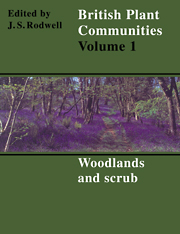Book contents
- Frontmatter
- Contents
- List of Figures
- Foreword
- Preface and Acknowledgements
- Preamble
- General Introduction
- Woodlands and Scrub
- Introduction to Woodlands and Scrub
- Key To Woodlands and Scrub
- Community Descriptions
- W1 Salix Cinerea-Galium Palustre woodland
- W2 Salix Cinerea-Betula Pubescens-Phragmites Australis Woodland
- W3 Salix Pentandra-Carex Rostrata Woodland
- W4 Betula Pubescens-Molinia Caerulea Woodland
- W5 Alnus Glutinosa-Carex Paniculata Woodland
- W6 Alnus Glutinosa-Urtica Jzozca Woodland
- W7 Ainus Glutinosa-Fraxinus Excelsior-Lysimachia Nemorum Woodland
- W8 Fraxinus Excelsior-Acer Campestre-Mercurialis Perennis Woodland
- W9 Fraxinus Excelsior-Sorbus Aucuparia-Mercurialis Perennis Woodland
- W10 Quereus Robur-Pteridium Aquilinum-Rubus Fruticosus Woodland
- W11 Quereus Petraea-Betula Pubescens-Oxalis Acetosella Woodland
- W12 Fagus Sylvatica-Mercurialis Perennis Woodland
- W13 Taxus Baccata Woodland
- W14 Fagus Sylvatica-Rubus Fruticosus Woodland
- W15 Fagus Sylvatica-Deschampsia Flexuosa Woodland
- W16 Quereus spp.-Betula spp.-Deschampsia Flexuosa Woodland
- W17 Quereus Petraea-Betula Pubescens-Dicranum Majus Woodland
- W18 Pinus Sylvestris-Hylocomium Splendens Woodland
- W19 Juniperus Communis Ssp. Communis-Oxalis Acetosella Woodland
- W20 Salix Lapponum-Luzula Sylvatica Scrub
- W21 Crataegus monogyna-Hedera helix scrub
- W22 Prunus Spinosa-Rubus Fruticosus Scrub
- W23 Ulex Europaeus-Rubus Fruticosus Scrub
- W24 Rubus Fruticosus-Holcus Lanatus Underscrub
- W25 Pteridium Aquilinum-Rubus Fruticosus Underscrub
- Index of Synonyms to Woodlands and Scrub
- Index of Species in Woodlands and Scrub
- Bibliography
W5 - Alnus Glutinosa-Carex Paniculata Woodland
Published online by Cambridge University Press: 04 July 2020
- Frontmatter
- Contents
- List of Figures
- Foreword
- Preface and Acknowledgements
- Preamble
- General Introduction
- Woodlands and Scrub
- Introduction to Woodlands and Scrub
- Key To Woodlands and Scrub
- Community Descriptions
- W1 Salix Cinerea-Galium Palustre woodland
- W2 Salix Cinerea-Betula Pubescens-Phragmites Australis Woodland
- W3 Salix Pentandra-Carex Rostrata Woodland
- W4 Betula Pubescens-Molinia Caerulea Woodland
- W5 Alnus Glutinosa-Carex Paniculata Woodland
- W6 Alnus Glutinosa-Urtica Jzozca Woodland
- W7 Ainus Glutinosa-Fraxinus Excelsior-Lysimachia Nemorum Woodland
- W8 Fraxinus Excelsior-Acer Campestre-Mercurialis Perennis Woodland
- W9 Fraxinus Excelsior-Sorbus Aucuparia-Mercurialis Perennis Woodland
- W10 Quereus Robur-Pteridium Aquilinum-Rubus Fruticosus Woodland
- W11 Quereus Petraea-Betula Pubescens-Oxalis Acetosella Woodland
- W12 Fagus Sylvatica-Mercurialis Perennis Woodland
- W13 Taxus Baccata Woodland
- W14 Fagus Sylvatica-Rubus Fruticosus Woodland
- W15 Fagus Sylvatica-Deschampsia Flexuosa Woodland
- W16 Quereus spp.-Betula spp.-Deschampsia Flexuosa Woodland
- W17 Quereus Petraea-Betula Pubescens-Dicranum Majus Woodland
- W18 Pinus Sylvestris-Hylocomium Splendens Woodland
- W19 Juniperus Communis Ssp. Communis-Oxalis Acetosella Woodland
- W20 Salix Lapponum-Luzula Sylvatica Scrub
- W21 Crataegus monogyna-Hedera helix scrub
- W22 Prunus Spinosa-Rubus Fruticosus Scrub
- W23 Ulex Europaeus-Rubus Fruticosus Scrub
- W24 Rubus Fruticosus-Holcus Lanatus Underscrub
- W25 Pteridium Aquilinum-Rubus Fruticosus Underscrub
- Index of Synonyms to Woodlands and Scrub
- Index of Species in Woodlands and Scrub
- Bibliography
Summary
Synonymy
Swamp carr Pallis 1911; Alder thicket Rankin 1911 b p.p.; Valley fen woods Farrow 1915; Alder wood Clapham 1940; Swamp carr and semi-swamp carr Lambert 1951; Alder woodland types 2c p.p. & 3c McVean 1956b; Alder carr Sinker 1962; Valley fen alderwoods Haslam 1965; Osmundo-Alnetum glutinosae (Klötzli 1970) Wheeler 1980c p.p.; Alnus-Salix woodland XXiii Meres Report 1980; Alder stand types 7Ba and 7Bb Peterken 1981; Scutellaria galericulata-Alnus glutinosa Association Birse 1982 p.p.; Woodland plot type 14 Bunce 1982 p.p.
Constant species
Alnus glutinosa, Carex paniculata, Galium palustre, Rubus fruticosus agg., Brachythecium rutabulum, Eurhynchium praelongum.
Rare species
Carex appropinquata, C. elongata, Cicuta virosa, Dryopteris cristata, Peucedanumpalustre, Thelypterispalustris.
Physiognomy
The canopy of the Alnus glutinosa-Carex paniculata woodland is characterised by the high frequency and often the great abundance of Alnus but its detailed floristics and physiognomy vary considerably according to the age of the stand and the nature of the substrate. Alnus and Salix cinerea are the most frequent invaders of the kinds of swamp and fen from which this woodland is derived and, in the early stages of colonisation, their proportions are very much a reflection of the chance availability of propagules and the frequency and disposition of sites where seedlings can gain a hold, very often here the tops and sides of Carex paniculata tussocks. In general, though, young stands are characterised by the co-dominance of these two species in low, uneven and open canopies and the general trend with ageing is for S. cinerea to be relegated to an understorey or, where the Alnus grows up to cast a deep shade, to be completely extinguished. Betula pubescens can also appear early in invasion but it is decidedly patchy and its overall frequency is no more than occasional. Once the canopy has thickened up, light quickly becomes insufficient for its establishment. In drier situations, on initially firmer substrates or in sites where the fen mat consolidates with the passage of time, Fraxinus excelsior can become frequent but it generally makes no more than a local contribution to the canopy. Quercus robur can also occur in such situations though it remains rare through the community as a whole.
- Type
- Chapter
- Information
- British Plant Communities , pp. 80 - 90Publisher: Cambridge University PressPrint publication year: 1991



